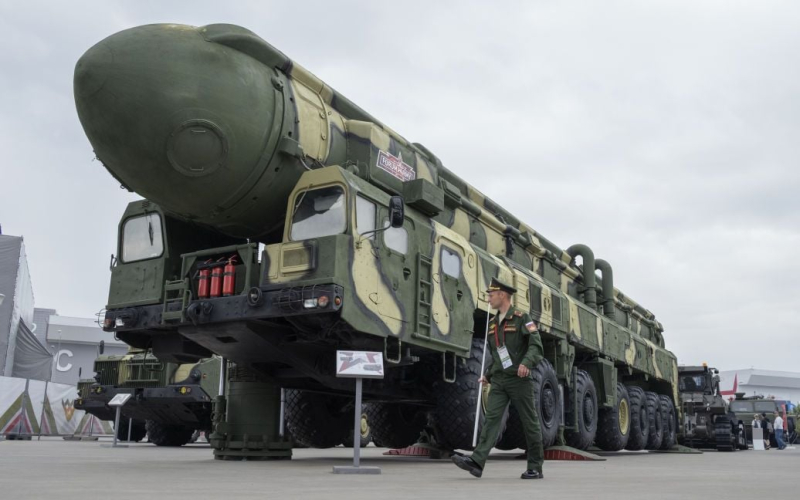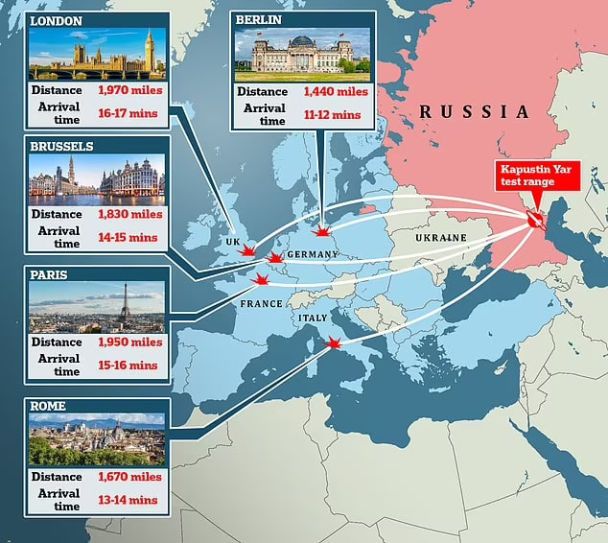
Experts also noted that "Oreshnik" has the potential to carry a nuclear warhead.
The experimental hypersonic missile “Oreshnik”, which Russia, according to Vladimir Putin, used on the Dnieper, has the ability to reach any city in Europe in less than 20 minutes. According to analysts, this strike is more symbolic than a real military threat, and is a bluff indicating the weakness of the Kremlin.
This was reported by the Daily Mail.
The “Oreshnik” missile is a hypersonic projectile developed by Russia, characterized by significant speed and range. Although it does not have the power of the Russian RS-24 Yars intercontinental ballistic missiles (ICBMs), which can hit targets anywhere in the United States, the Oreshnik has a speed ten times faster than the speed of sound (12.2 thousand km/h) and can travel up to 5,000 km.
According to calculations by the Daily Mail, by launching missiles from the Kapustin Yar test site, Putin “could easily hit any target in Europe or the UK without resorting to his powerful weapons.” In particular, London could be hit in less than 20 minutes, and Berlin in less than 15. In addition, the Oreshnik has the potential to carry a nuclear warhead, although it was equipped with conventional warheads during the strike on Ukraine.

The Oreshnik missile, as reported by the Pentagon, was created on the basis of the RS-26 Frontier, a medium-range missile capable of carrying nuclear weapons. The RS-26 has a range of 5,800 km, although most tests have been conducted at a shorter range. Experts suggest that the Oreshnik is a less powerful and lighter version of the RS-26, with a range of up to 5,000 km.
According to information released by the Daily Mail, Russia could have used a missile with independently targetable main warheads, typically used in nuclear intercontinental ballistic missiles (ICBMs). Such missiles can carry multiple warheads, each of which can be brought to individual targets.
Experts say Putin's use of advanced hypersonic weapons in a conventional strike was costly, but was a clear signal of a possible escalation of the conflict.
“This strike has no obvious military value – they could have achieved the same objective without sacrificing (an ICBM or advanced missile),” says Dr Ruth Deyermond of King's College London.
Russia has indeed demonstrated its weakness, she says, because the Kremlin is well aware of the consequences of using nuclear weapons.
“It looks like it's signaling to the West what Russia could do if it wanted to – launch a nuclear missile. But in reality it's a sign of weakness. The Russian government knows what will happen to it if it tries to use any nuclear weapons, so he has to resort to bluff,” the expert added.
RAND Europe analyst Dr. Matthias Ecken also notes that the range of such missiles (700 km to the Dnieper) does not match the characteristics of traditional intercontinental missiles.
“Nevertheless, such a strike could have symbolic significance. The message that Putin and Russia are trying to send to the West is this: we also have missiles that can strike anywhere in the world. In particular, after the US allowed the use of ATACMS/Storm Shadow against Russia, Putin may have considered it necessary to demonstrate Russia's ability to use long-range missiles as well,” the expert noted.
Recall that Putin announced the serial production of Oreshnik ballistic missiles.
Related topics:
More news

